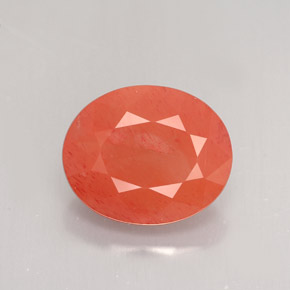The Gemstone Andesine

Andesine is a red feldspar gemstone, sometimes with greenish
hints and a slight labradorescent effect. Andesine is a relatively new gem on the market. It first appeared in 2003, though its exact origins were never fully disclosed. There are those who believe that a limited deposit of natural red Andesine from an alluvial source in Congo is the origin of this material. Although this is possible, it has yet to be proven. Aside from a possible natural stock from the Congo, the material on the market today is produced in China by artificially enhancing Labradorite through diffusion treatment with copper.
Color
?
Red, Green, Yellow, Orange, Pink, Multicolored
Chemical Formula
?
(Na,Ca)Al
1-2Si
3-2O
8
Mineral Class
?
Plagioclase feldspar (Also see the minerals
Andesine and
Labradorite))
Additional Properties
|
Refractive Index
?
1.560 - 1.568 |
Double Refraction
?
.008 |
Transparency
?
Transparent to translucent |
SG
?
2.69 - 2.70 |
Luster
?
Vitreous |
| Cleavage ?
2,1 - basal ; 2,1 - prismatic ; 3,1 - pinacoidal. |
All About
Andesine has a lovely red, reddish pink, and orange-pink color. This pretty color gave it a unique position as a new gemstone, because can rival the color of other more valuable red gemstones. However, it is still soft for a gemstone, and it is prone to cracks from pressure. A few examples of Andesine may even exhibit a color-changing effect in different lighting.
The problem with Andesine is its lack of authentication. The original Andesine gems being sold were lacking details in their color treatment and origination. Although some claim the original gemstones from Congo as naturally colored, much of the material being offered for sale today is copper-
diffused Labradorite. A class action lawsuit has been filed against one of the companies that popularized the diffused material for their lack of disclosure that the gemstone is synthetically colored.
Uses
?
Andesine is faceted into gemstone cuts, and can be used in various forms of jewelry. It is sometimes used as an inexpensive replacement for more expensive red gemstones such as
Ruby and
Spinel.
Treatments & Enhancements
?
The color of the Andesine gemstones being produced in China is produced by subjecting
Labradorite to
diffusion treatment with copper.
Andesine Sources
?
The origin of Andesine gemstones is uncertain. The original source where this gem was supposedly discovered in a natural, untreated state is in the Congo, near the Nyaragongo Volcano. The source for the
diffused material is the Inner Mongolia of China.
Similar Gemstones
?
Andesine should not be confused with
Sunstone, which is a natural
reddish
feldspar gem. Sometimes Andesine gems are intentionally
mislabeled as Oregon Sunstone to promote higher prices. Sunstone can easily be distinguished by its glitter effect, or
aventurescence.
The red gemstones
Ruby, Spinel, and
Rubellite Tourmaline are all harder then Andesine.